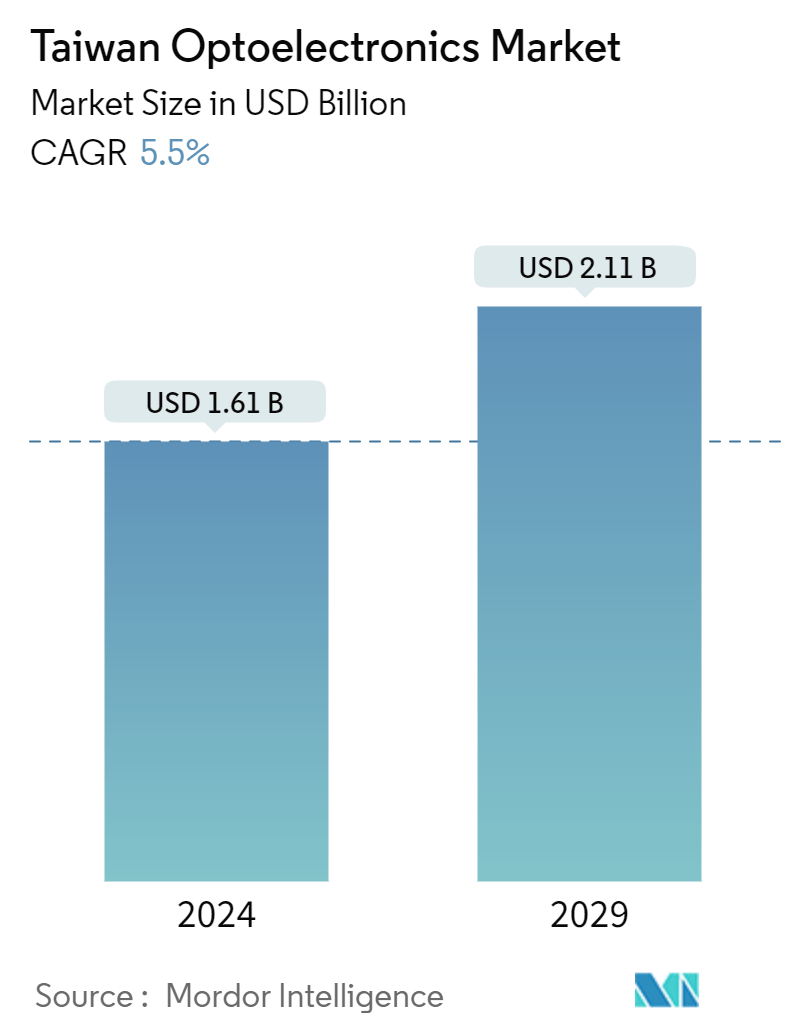Market Size of Taiwan Optoelectronics Industry

| Study Period | 2019 - 2029 |
| Base Year For Estimation | 2023 |
| Market Size (2024) | USD 1.61 Billion |
| Market Size (2029) | USD 2.11 Billion |
| CAGR (2024 - 2029) | 5.50 % |
| Market Concentration | Low |
Major Players
*Disclaimer: Major Players sorted in no particular order |
Taiwan Optoelectronics Market Analysis
The Taiwan Optoelectronics Market size is estimated at USD 1.61 billion in 2024, and is expected to reach USD 2.11 billion by 2029, growing at a CAGR of 5.5% during the forecast period (2024-2029).
- The current trends in the optoelectronics market focus on minimizing the dimensions of devices and enhancing integration within systems, such as arrays of LEDs, laser arrays, and systems that incorporate other electronic components on a single chip. The merging of optical communication, optical storage, and optical imaging sectors is pushing advancements in optoelectronics. The Increasing need for intelligent consumer electronics and cutting-edge technologies in Taiwan is expected to drive the use of optoelectronics.
- LED technology development has seen significant advancements over the years in Taiwan. Initially, LEDs were available only in a few basic types and colors. Still, new types of chemical structures, such as InGaAIP and GaAIAs, have been created to obtain new colors and wavelengths and improve performance and reliability. In January 2024, Taiwanese company AUO, specializing in optoelectronic solutions, began producing Micro LEDs at the close of 2023. These Micro LEDs target high-end smartwatch manufacturers, focusing on achieving cost efficiency.
- 5G technology, enabled by optoelectronics, supports extended reality (XR) applications, which encompass virtual reality (VR), augmented reality (AR), and mixed reality (MR) experiences. Taiwan is spearheading initiatives to accelerate the rollout of 5G and 6G communication technologies. The rising uptake of 5G networks is poised to propel the market's growth in the nation significantly. According to GSMA, in 2023, 5G mobile connections in Taiwan accounted for 37%, projected to surge to 56% by 2025 and 96% by 2030.
- Manufacturing and fabricating optoelectronics entail high initial costs, posing notable restraints in the market. Despite rising demand across industries, these costs impede market growth. The industrial sector, particularly in laser and machine vision systems, is witnessing a surge in demand for optoelectronic components fueled by the adoption of advanced manufacturing technologies. The sector's high manufacturing costs are partly attributed to notable technological advancements in optoelectronics.
- Inflation, a key macroeconomic factor, notably influences the manufacturing landscape, often translating to escalated production expenses. This uptick in costs may be attributed to several reasons, including surging raw material prices, heightened shipping expenses, and labor shortages. Consequently, manufacturers might be compelled to hike prices to safeguard their profit margins, which typically dampens consumer demand. Inflation may trigger contract constrictions, labor realignments, and procurement challenges for manufacturers. Given these dynamics, the mounting inflationary pressures could impede the studied market's growth trajectory.

